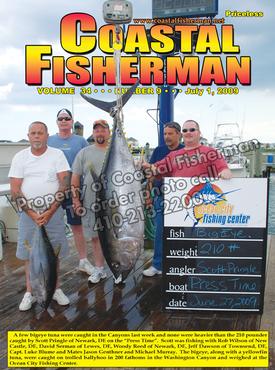


Article by Pat Schrawder
 DON’T OVERLOOK YOUR TRANSDUCER
DON’T OVERLOOK YOUR TRANSDUCER
This is the time of year when boaters are installing new fish finders or repairing their old ones in preparation for the 2009 season. One of the critical elements for your fish finder is its transducer (the part that is mounted through the hull or on the transom).
Your fish finder and its transducer work as a system. The fish finder sends a signal out from the display unit through the transducer cable and out from the transducer element.
Internally, the transducer element vibrates at a specific frequency creating acoustic energy or sound waves that travel through the water, either dissipating, being absorbed or returned. The receiving signal is collected and returned back to the display where the image is shown. Both the transducer and the display are manufactured with certain frequencies and those much match. Similarly, the output power of the display must coincide with the power of the transducer. If the output power of the display is greater, it can “blow out” the transducer element and if it is too much less, the transducer will not fire properly.
Transducers come as single element units that vibrates alternately at 50 kHz and 200 kHz or multiple element units that fire their independent elements individually. They also may contain speed wheels and/or temperature sensors. These transducers are generally referred to as Tri-ducers and they are by far the most popular in today’s market. Once again, however, you can only use a tri-ducer that is compatible with your particular fish finder. You can also find transducers that are single frequency but it is not the typical request. Having two frequencies allows you to have the best of both worlds. The higher frequency (200 kHz) has a narrower beamwidth and is better for shallow water whereas the lower 50 kHz units see into deeper water and cover a wider area. The trade off is that they produce less detailed images.
Once you have made sure that the frequency and power are correct, there are still decisions to be made. Top of the list is where and how it will be mounted. Transducers that are mounted through the hull are often considered to give superior performance and are typical for higher power models. This comes with several drawbacks, however. They require that a hole be cut in the hull, making the installation lengthier and more critical in that they must be adequately sealed to prevent water from entering the hull. They are more difficult to access for periodic cleaning and they may present a problem for trailerable boats as you must install them at a spot where the trailer will not hit the transducer when you take the boat on and off.
Transom mount transducers are the simplest to install and are less expensive. They do not require a hole to be cut in the hull. They are easier to access when they need cleaning and if you need to replace a speed wheel. There are certain things you need to observe, however, when mounting them. They should be kept as far away as possible from any turbulence as occurs with the prop wash and they need to be angled slightly forward.
A third option is to mount the transducer in-hull. The signal shoots through the hull and that eliminates the problems associated with turbulence and cleaning. The downside to these is that you sacrifice performance as you will cut down your power. Boats with aluminum or steel hulls cannot use this type. Many wooden boats will also have a problem. Only fiberglass boats with no flotation core are good candidates for this. Also keep in mind that your transducer will not be able to support the “speed” function or give you water temperature readings because they do not touch the water.
One final thing to keep in mind is that more than one transducer firing at the same frequency at the same time can cause interference that makes your signal unreliable or noisy. This means you can have more than one fish finder of the same operating frequency on your boat but you cannot use them both at the same time. You can also experience the same problem if you are closely alongside another boat and both of you have your fish finders on.
Don’t install a transducer yourself unless you are fully acquainted with the proper procedures. An incorrectly installed or improperly matched transducer can make even the best fish finder a waste of money.
Pat Schrawder and her husband Larry are owners of L&L Marine Electronics on Golf Course Road in West Ocean City.